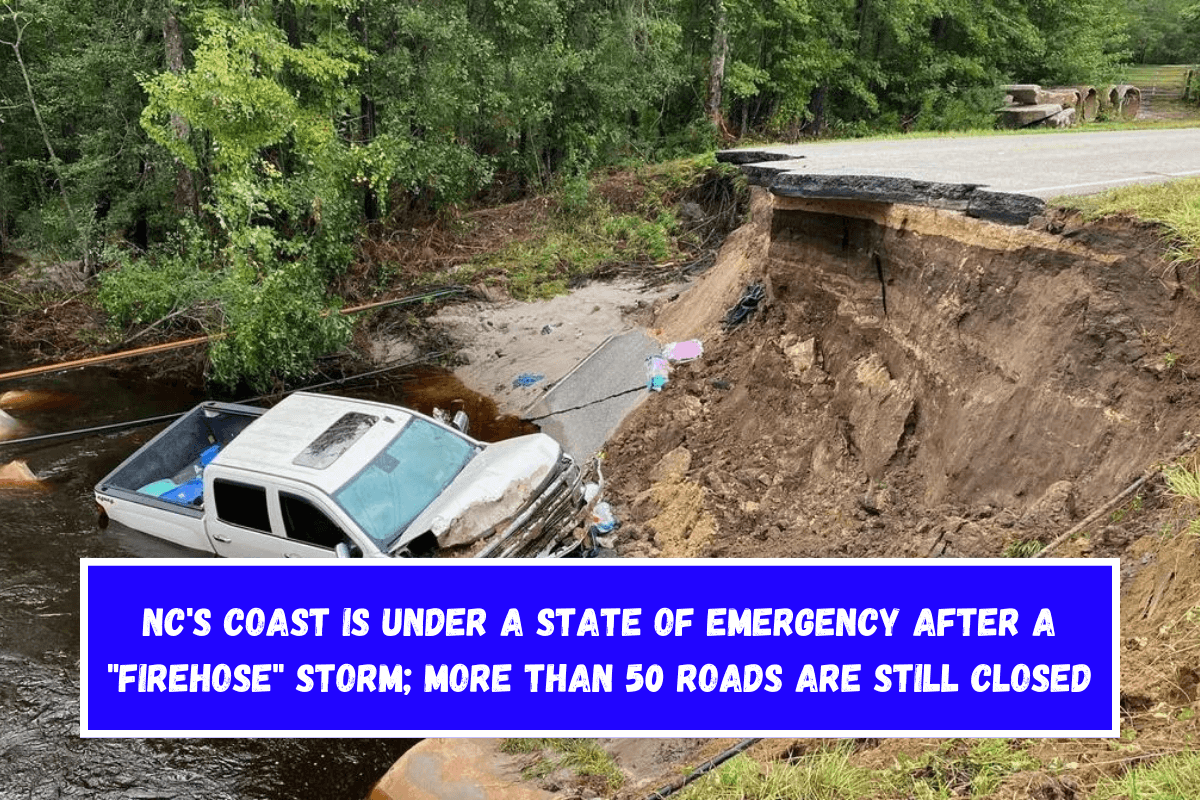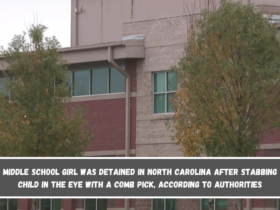RALEIGH, N.C. — More than 50 roads, many schools, and businesses were still closed Tuesday in southeastern North Carolina counties because of the storm that hit the coast Monday and caused a tornado and nearly 21 inches of rain near Wilmingto. On Monday, Gov. Roy Cooper announced a state of emergency in those counties.
The weather service in North Carolina warned of a storm that could bring heavy rain, up to 8 inches in some places. But a small area got a “firehose” that dumped record-breaking amounts of rain in a so-called “1,000-year flood.” This caused flash floods that damaged many homes, businesses, and roads.
As of Tuesday, 52 roads in 12 counties were closed. This included seven major routes and an important coastal highway. Most of the roads were closed in Brunswick County, which has had no school this week.
Some of the most important roads are closed: parts of U.S. 17, N.C. 211, and N.C. 133 in Brunswick County; and a section of N.C. 12 at the northern end of Ocracoke Island.
This is because of the storm on Tuesday, which flooded homes, sank cars, and shut down schools in Bladen, Brunswick, Columbus, and New Hanover counties.
The heaviest rain fell on Carolina Beach, which is south of Wilmington. In 12 hours, it rained more than 18 inches, and it rained almost 21 inches all together. Meteorologists at the National Weather Service office in Wilmington said that much rain is enough to cause a 1,000-year flood, which only happens once every 1,000 years.
NWS analyst Lauren Warner said that some places were hit especially hard because the storm moved quickly across the area, “causing a bit of a firehose effect.” The weather service thought it would rain “locally higher” amounts, but that’s not even close to what actually fell.
Because of the heavy rain, creeks and streams were flooded, which did a lot of damage to U.S. 17 and kept it closed Tuesday south of Wilmington.
Since the main highway is closed, there is no direct way to get from Wilmington to the islands in Brunswick County, such as Oak Island, Holden Beach, Ocean Isle Beach, and Sunset Beach. There is damage to even some side roads around U.S. 17 from the floods.
Warner, a weather forecaster, said, “If that had moved just a little to the left or continued to the left, that would have lowered some of the totals we saw or maybe spread them out over a larger area.” Parts of just two counties were hit by the worst floods, according to her coworker Tim Armstrong.
Carolina Beach was hit the hardest. Ocean Isle Beach, which has less than 4 inches of rain, is just over 30 miles away.
Based on 50 calls for help, firefighters were able to save 117 people in Carolina and Kure Beach, as well as almost 20 pets.
Cooper said that declaring a state of emergency will make more help available for the area.
On Ocracoke Island, the storm shut down the weak coastal highway N.C. 12 and put at risk several homes in Rodanthe. In just four years, erosion and rising sea levels have destroyed more than six beachfront houses in Rodanthe.
While living in a place that gets a lot of tropical rain, Carolina Beach Mayor Lynn Barbee said that his town could not have been fully ready for the 21 inches of rain that fell.
Barbee, who has lived on the coast his whole life, said, “I don’t think I’ve ever seen it rain so hard and for so long.” “Not bands of rain that get stronger and then stop, or a front moving through.” It was right on top of us.
The storm system was called Potential Tropical Cyclone No. 8, but it never got organized enough to be named the eighth tropical storm of the season.
Bribee said that the fact that it didn’t have a name made it harder because people pay more attention to storms or hurricanes that have names. Even though it was pouring rain Monday, people were still coming to the beach for holidays. “One family from Pennsylvania lost their van in the floods,” the mayor said. “They are now staying in a shelter instead of their vacation rental.”
“We’ve set up a way to talk to each other.” On the Saffer-Simpson scale, we talk about uncertainty cones, predicted paths, arrival times, and strength. Everyone knows what to expect. Barbee said, “All of a sudden, we’re having storms that don’t fit on these scales.”
The mayor thinks that Carolina Beach will be back to normal by the weekend, but the cleanup work is still going on. But the people in charge of the town will keep trying to figure out how to prepare for heavy rain in the same way that they prepare for 18 inches of water to come in from the ocean during a hurricane.
“Where does a foot-and-a-half that falls from the sky instead of the ocean go?” He told Barbee. “It’s showing up in places that have never flooded before.” The water is dropping, not rising.
During the day, floodwaters covered parts of U.S. 17 and trapped some cars on high ground that turned into an island.
Emergency workers in Brunswick County brought food and water to people who were waiting for the water to go down, according to emergency officials. Even though no one was killed, dozens of roads in the county were destroyed or washed out.
Tuesday, Gov. Roy Cooper signed an order establishing a state of emergency for Brunswick and three other southeastern counties. The governor said that this will allow the area to get more help.
By any measure, it wasn’t the first major flood in the area. There have been four other floods of a lifetime in the same area in the last 25 years. Hurricane Floyd in 1999, storms with no names in 2010 and 2015, and Hurricane Florence in 2018 with 30 inches of rain were the worst.
The Atlantic storm season lasts until the end of November.
The National Oceanic and Atmospheric Administration still predicted a very busy hurricane season in a new report released last month. This was because of near-record sea surface temperatures and the chance of La Nina. Officials in charge of emergency management have told people to stay ready.
In other parts of the Atlantic, Gordon stayed a tropical depression even as it moved through open water. Forecasters say Gordon could either weaken and go away in the next few days, or it could get stronger and turn back into a tropical storm.















Leave a Reply